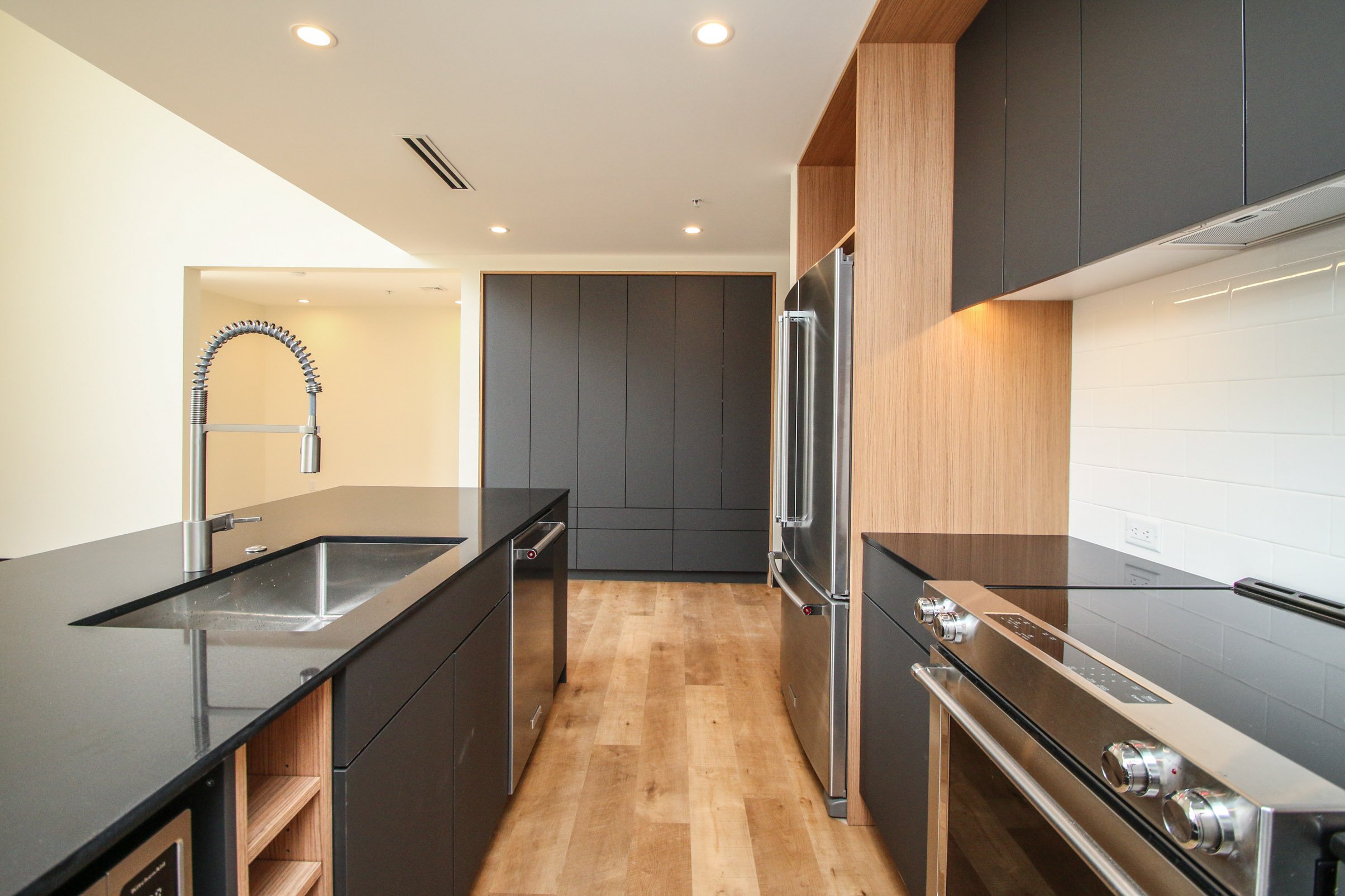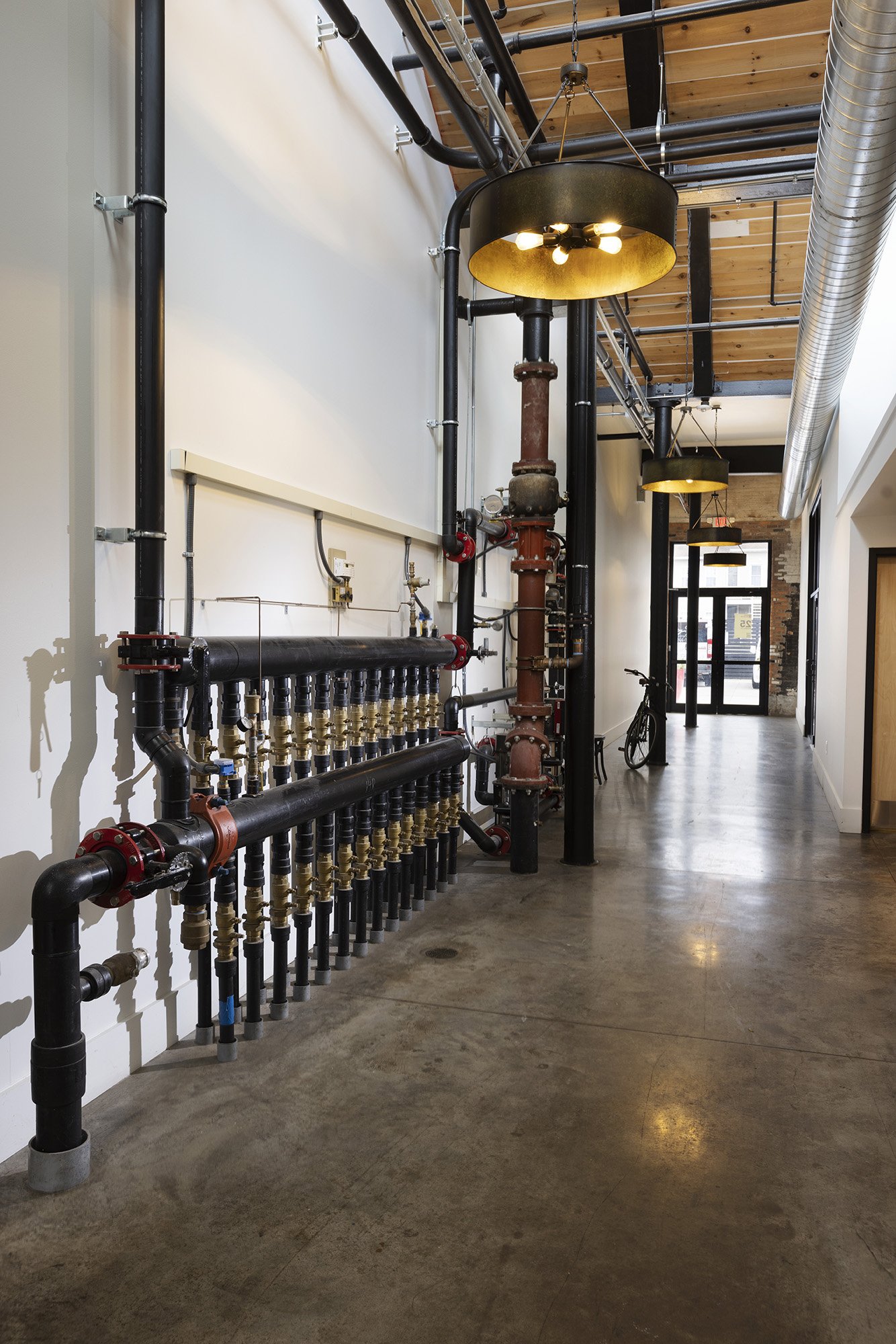Digging Deep Pays Back in Spades
Ground-Source Heating and Cooling at the Factory & the Factory Lofts
Photos by Lauren Petracca
Getting Creative with Adaptive Reuse
High ceilings and large swaths of glass – these features of older buildings make apartment hunters swoon, and can also make traditional heating and cooling costs painfully high. “My dad and I wanted to get into doing the geothermal component on adaptable reuse projects like this one. It’s a great way to make these old buildings work.”
The Factory and the Factory Lofts reside in a 40,000 sq foot brick building on Russel Street in the heart of Rochester’s Neighborhood of the Arts. This vibrant mixed-use complex contains apartments, restaurants, and businesses, all completely heated and cooled by geothermal.
Project Highlights
<10 year payback
Low utility bills for tenants
Preserved the building’s unique aesthetics
The Factory’s unique sawtooth roofline is one of the features that makes this turn of the century building an architectural gem, but also posed a challenge for traditional roof placement of heating and cooling units. When Luke and Gary Dutton of Dutton Properties investigated geothermal as an option for the site, they found that it would allow them to put HVAC components exactly where they were needed, without waste, controlled individually by each tenant.
The Factory
The Factory has a number of well known commercial tenants, like the upscale eatery Nosh and marketing agency Truth Collective. Most commercial tenants have never experienced operating a business in a building powered by geothermal, so they don’t know exactly what they’re signing up for. Luke says about Nosh, “They were along for the ride and trusted me to do it. They let us put in every geothermal component… the wine room, the dehumidifier, even the ice cube machine runs on the geothermal system.”
The Factory Lofts
The same can be said for potential residential tenants. “Geothermal is still kind of new, people don’t really understand it until they live in a space that has it. Once they live in a space and love it, they get it.”
Luke’s enthusiasm is contagious when he talks about the waste-reduction involved with operating geothermal in residential spaces. He describes the efficiency of an apartment building with all of its appliances running on geothermal heat. “When one person is running A/C, another person might need heat somewhere else. You really are sharing energy, you’re not wasting it.”
Geothermal Perks for Tenants
Clean, healthy air
Quiet heating and cooling
Low utility bills
Stable, comfortable temperatures controlled by the tenant, year-round.
Minimal ductwork makes for more aesthetically pleasing spaces
Happy people, low turnover
Making the Numbers Work
The Duttons know that the addition of geothermal will increase a building’s assessment, but not enough to cover the cost of the investment. They look to take advantage of available rebates and incentives to help the numbers pencil out. This requires determination and patience, but developers say that the process is starting to get more streamlined.
Geothermal’s higher upfront cost and longer project timelines can be daunting to business owners and developers alike, but Luke is calm and confident when he says, “The end result is totally worth it.” Now that they have several geothermal projects under their belt, they’ve found they can roll the lessons learned from one project into the next.
Finding the Fit
Every geothermal project is different. Things like the condition and horizontal size of the parking lot, the energy efficiency of the building, and the proximity to other buildings that could share wells all factor into deciding whether geothermal is the right fit.
When Dutton Properties needs additional support on a project, Luke calls up AJ Heiligman at Aces Energy. Aces Energy specializes in geothermal and solar, providing technical expertise, on-site labor and installation, and strong relationships with local drillers.
There are three things AJ talks about right away when people are curious about geothermal for their for their building project.
First, he offers to bring them over to the Factory so they can see the engineering at work, and get comfortable with the technology. He says, “The tech has been around for over 50 years, so don’t be scared of it. It’s not new, it’s just gotten more efficient.”
Second, he asks them to think about comparing geothermal to their “second best alternative.” At the Factory, that second best alternative would have been gas-power, requiring conventional air conditioning equipment mounted to the roof or building exterior. For this 1919 former warehouse, the Duttons said an easy “no” to an option that would produce more carbon emissions, take up valuable roof space that could be used for solar panels, and take away from the building’s architectural character.
Third, he walks people through ways to think about financials that go beyond the upfront cost. Many people who approach Aces Energy have aging infrastructure and are already planning to spend significant dollars on an upgrade. He encourages them to think about what they would already need to spend to replace their boiler with another gas-powered system, and compare that to the cost of a geothermal system that can be offset by rebates, tax credits, and the potential tax benefits of geothermal’s faster depreciation schedule. For many people, that full picture cost comparison starts to look very attractive.
Air pollution from the burning of fossil fuels is a key contributor to chronic respiratory illnesses like asthma, bronchitis, emphysema, and COPD. Reducing emissions through electrification should improve local air quality and result in better health, fewer missed work and school days, lower healthcare costs, and a better quality of life.
Many heat pump projects see a payback of less than 10 years, all the while benefiting from up to 65% increase in efficiency over traditional HVAC units.
Rule of Thumb
One 500ft well services roughly 1500 sq feet of occupied building space. For a 10,000 square foot building, you may need 6 or 7 wells.
Quick Geothermal Tips for Building Owners
Find the right site
Get started with a project and build experience
Work with people who specialize in the technology
Pair it with solar for further cost reduction
Investigate available rebates, tax credits, and potential tax benefits to get a true cost comparison.
The next time you visit a friend at the Factory Lofts, stop in for fine dining at Nosh, or swing by for a meeting at Truth Collective, take a moment to think about the power beneath your feet. Going electric is clean, efficient, and good for all of us.
Will your next retrofit or new build project Go All Electric?







